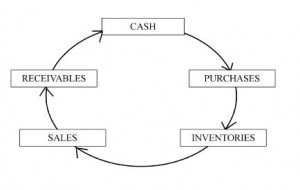Manage Working Capital to Increase Business Value
 As you likely know, working capital equals current assets minus current liabilities. Companies that have a high level of cash tied up in current assets (primarily cash, accounts receivable, and inventory) without similar levels of current liabilities are not as attractive as those who tightly manage their working capital. Buyers are often leery of businesses that require high working capital to sales ratios because as sales grow the company must continually invest more cash in working capital. Conversely, companies with low working capital can grow faster and return more cash to shareholders as they grow.
As you likely know, working capital equals current assets minus current liabilities. Companies that have a high level of cash tied up in current assets (primarily cash, accounts receivable, and inventory) without similar levels of current liabilities are not as attractive as those who tightly manage their working capital. Buyers are often leery of businesses that require high working capital to sales ratios because as sales grow the company must continually invest more cash in working capital. Conversely, companies with low working capital can grow faster and return more cash to shareholders as they grow.
One Recent Example
We were recently retained to do a fair market value business valuation of a multi-state, value-added industrial distribution company for a shareholder buyout. The company was a profitable going concern. While it showed modest EBITDA margins, its working capital requirements were unusually high, primarily due to extraordinarily high accounts receivable and inventory levels.
A prior valuation done not long ago for a different purpose had relied solely on an Asset Approach method. Specifically they used the Adjusted Book Value (ABV) method where all assets and liabilities are marked to market. Thanks to the company’s high current assets combined with almost no current or long-term liabilities, the result was a high valuation number. As part of our analysis, we naturally considered the prior valuation. We wondered how valid its conclusion was from the perspective of a hypothetical buyer of a going concern business who would be concerned with future cash flows.
Following standard business valuation practice, we considered the three approaches to valuation: asset, market and income. The asset approach using ABV gave results marginally higher than the prior valuation while the market approach (comparable asset transactions method) values were slightly lower. However, when we analyzed the income approach using a single period capitalization method (SPCM), our result was substantially lower than the asset approach. Why? Because the SPC method is based on capitalization of net cash flow to equity holders, which considers changes in working capital that are largely ignored by the asset and market approach.
We were compelled to give some weight to the income approach results as we believe knowledgeable buyers of shares in the company would have a strong interest in their expected return on investment. The result was a valuation conclusion somewhat lower than adjusted book value.
Theory Holds True in Practice
I want to point out that this affect of working capital on enterprise value isn’t just abstract financial theory. We regularly see it play out in actual M&A transactions where buyers have no interest in paying more for companies with higher working capital. And we often see sellers rewarded (sell for higher earnings multiples than their industry peers) for having proven that they can operate effectively with less working capital.
It is also interesting to note that in this case, should the owners of the company have tried to liquidate the company’s assets to generate cash, the net amount yielded would have been substantially less than adjusted book value. Given that the company had no plans to liquidate, we didn’t consider using a liquidation value.
What Companies Should Be Doing in this Area
Company owners and management should constantly reevaluate and consider modifying their accounts payable and borrowing practices, as well as focus on ways to reduce accounts receivable and inventory requirements. All of which will reduce working capital, generate cash, enable faster growth, and increase shareholder value. Sometimes this even means making tough decisions like firing a customer or replacing a key vendor.
For further information on how working capital affects enterprise value, or to have a business analyzed for sale, acquisition or exit planning purposes, contact Jim Leonhard, CVA MBA at 916-800-2716 or jhleonhard@exitstrategiesgroup.com.



